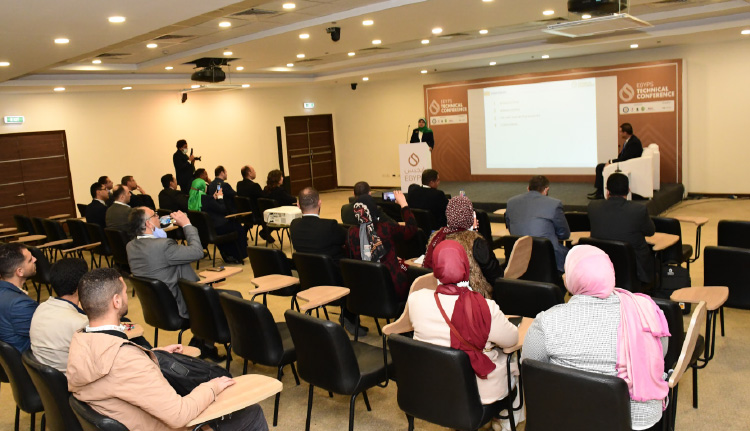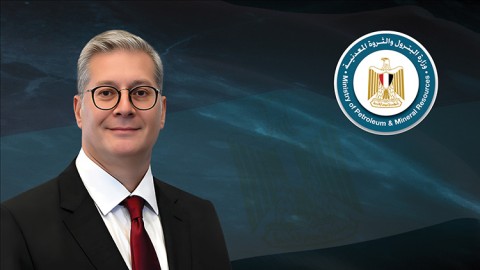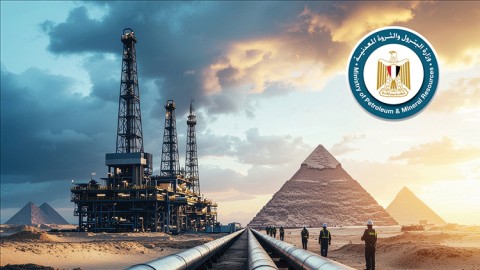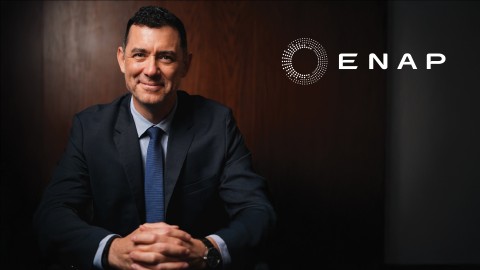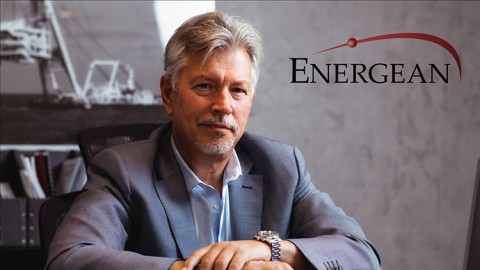As a platform that brings national, regional and international oil & gas players together, EGYPS also serves as a meeting point for the industry technical experts from around the world who take the stage to share their expertise and insights with colleagues from around the world.
At the Technical Conference of EGYPS 2022, 40 sessions were delivered by more than 150 speakers from 25 countries. The conference covered several topics including exploration, field development and drilling, project management, operational excellence and health, safety and environment (HSE).
The first day of the conference had a flow of discussions aimed at giving insight into the conference’s theme “Delivering Energy Today and Shaping the Future Energy Agenda”. Each technical presentation aimed at providing new and innovative solutions under the umbrella of the conference’s theme.
The technical session was co-chaired by Wael Korosh, Drilling and Completions Technical Advisor, Halliburton and Ahmed Atif, EUG Project Manager, Schlumberger. The technical session entitled “Smart and Digital Solutions” discussed various essential points that would aim to revolutionise the technical section of the oil and gas industry. The technical session included three imperative and interesting presentations.
The first presentation by Islam Zaki Ibrahim, Instruments and Control Maintenance Section Head, Egyptian Projects Operation and Maintenance (EPROM), Egypt addressed “Industrial Internet of Things (IIoT) data integration while mitigating cybersecurity risks”.
Ibrahim began his presentation with an introduction about the importance of the Industrial Internet of Things (IIoT) in the oil and gas industry. Ibrahim said that some of the benefits of IIoT included “Using big data analysis for air-coal mix injection profiles during the cycle that automatically adjust the excess of air, avoiding waste of unburnt fuel increasing the combustion efficiency up to 6%.”
Ibrahim also mentioned that, from the business viewpoint, the IIoT attends to the concerns of the identification of stakeholders and their business visions, values, and objectives in establishing an IIoT system in its business and regulatory context.
He concluded his presentation by saying that the IIoT has many advantageous features in the oil and gas industrial sector. These included, but were not limited to, ease of deployment, scalability, quick decision-making processes and big data compilation monitoring and analysis.
The second presentation addressed “Transforming Digital Twins Through Innovation”. The speaker was Emad Gebesy, Senior Solution Consultant MENA at Aspentech in Qatar. Gebesy started off by introducing operational excellence with performance engineering through case studies.
Additionally, Gebesy noted that offline digital twins have some benefits such as identifying targets to achieve maximum energy recovery, reducing energy consumption through heat integration, optimizing the performance of new and existing heat exchanger networks and improving sustainability and reduction in the overall carbon footprint.
Gebesy concluded by saying that “The end-user in the offline digital twins may have no offline digital experience or technical experience, such as technicians or non-engineers, however, for the online digital twins requires technical experience and a trained background as it needs visualization.”
Ben Oudman, Director and Regional Manager, DNV GL, CEMEIA concluded the session with a presentation on “Creating trust and value from digital twins”.
Oudman explained that there is a lack of trust in digital twins as human users to give the final say and call when a decision is needed. For this reason, it is crucial to increase user trust in digital twins as the technology becomes progressively more accurate and efficient.
He elaborated by mentioning that it is essential to have a quality indicator to act as a “self-diagnostic indicator that reports the trustworthiness of the results from the Functional Element.” By implementing a quality indicator, the digital twins’ level of trust would increase accordingly.
Oudman concluded by saying that “The organization needs to be ready and mature in order to have a successful execution.”
Revolutionizing the Gas Sector
The second day of EGYPS Technical Conference tackled several discussions. The first technical session was co-chaired by Hamada Ahmed Mohamed, Deputy General Manager of Gas Facilities, Egyptian Natural Gas Holding Company (EGAS) and Ehab El Gayesh, Senior Contract Performance Manager, Baker Hughes.
The technical session, which was held under the title “Operational Innovations in Gas/LNG,” included four presentations addressing ‘Gas/LNG Processing, Transportation, Operations and Technology. The first presentation addressed “Piping vibration analysis and effects”. The speaker was Kamal Abo El-kamal, Senior Reliability and Condition Monitoring Engineer, Petrobel, Egypt.
Abo El-kamal kicked off the technical session by indicating that, “Vibration induced fatigue failures of pipework are a major concern due to associated issues with safety, production, cost, environmental impact and sudden release of pressurized fluids.”
Additionally, Abo El-kamal mentioned that there are various different types of piping vibration assessments. On a similar note, he added that in a particular case study, “EI guidelines, piping stress analysis, Operational Deflection Shape (ODS) methodology and modal analysis [were implemented] while putting into consideration the change of gas upstream and downstream parameters.” In doing so, the piping vibration analysis was carried out successfully.
Mohamed Atwa, Senior Production Technology Manager, Kuwait Energy, Egypt contributed to the session with a presentation on “Fiberglass pipelines application growth and challenges in Egypt”. He introduced his idea about the benefits and challenges of Fiberglass applications in Egypt.
When discussing the Al Jahraa Gas Pipeline project, he indicated that the main aim of the project was to “Allocate gas pipeline installed between Al Ahmadi and El Salmiyah field.” El Atwa explained that “a lot of challenges were faced during the planning and execution of this project.”
Despite the challenges associated with the project, Atwa elaborated that there are multiple advantages of using fiberglass pipeline, such as “lower cost, higher construction speed, high corrosion resistance, low pipeline roughness, no wielding or inspection is required and [there is an] adequate pressure rating to handle required inlet and discharge pressures.”
Dr. Hassan Elnagar Hassan, Assistant General Manager of Operation, Alexandria National Refining and Petrochemicals Co. (ANRPC), Egypt, concluded the session with a presentation on “Improving the waxy crude oil flows by using innovative polymer as pour point depressant”.
He added to his presentation with the fact that Pour Point Depressant (PPD) consumption in Egypt is high and that the problem is that “the crude oil is liquid in the reservoir temperature (70-150C) and pressure (500-1,000 bar). Once the crude oil leaves the reservoir, its temperature begins to drop due to heat loss.”
Hassan explained over the course of the scientific research, “it was found that the doped polymer were more efficient as PPDs than undoped polymer.
In another session, a group of four presenters discussed “Tackling gas processing challenges”. They have shared the studies conducted on some fields to mitigate such concerns. The technical session was co-chaired by Nicolas Droushiotis, Senior Project Engineer, Cyprus Hydrocarbons Company and Aamer Mohamed, Egypt Planning Lead, Apache Egypt.
The first speaker was Fawaz Agizah, QA/QC General Manager, Rashid Petroleum Company (Rashpetco), Egypt. He presented the “Challenging success for the production chemistry application programme in WDDM subsea production facilities – a case study”.
According to Agizah, there are several field applications challenges and limitations that need to be taken into consideration for such applications. Some examples of such challenges range from the accumulation of huge amounts of liquid hold up in the subsea network (which could inhibit productivity) to having a shortage in chemical injection lines whether on onshore or in subsea facilities.
He concluded that with some recommendations such as, “it is necessary to consider the availability of injection lines for chemical treatment products of gas, oil or condensate to avoid utilizing the existing injection line which [are] used for industrial chemicals such as Methanol and MEG”.
Ehab Elghayesh, Senior Contracts Performance Manager, Baker Hughes, Egypt introduced a presentation on the “LNG processing, transportation, operations and technology”. Elghayesh discussed the global view of the LNG process chain, LNG trade and refrigeration drivers as well as Baker Hughes’ contribution to the LNG industry in Egypt.
Elghayesh noted that “for sure, we have a lot of lessons learned, we have a lot of experience. We are going to use our history in LNG to create a new model to enhance operations.”
Mohamed Kamal Gaber, Senior Process and Pipeline Design Engineer, PETROJET, Egypt, delivered a presentation on the “Flare gas recovery – multi approaches”. Gaber discussed the approach to reaching a solution to mitigate loss or waste of energy and heat through flare gas. Gaber noted that “there are 3 approaches to solutions for gas flare recovery; these are LRC, MPP and C3 recovery.”
Innovating HSE
Also, the third day of the EGYPS technical conference comprised several significant topics. The first technical session entitled “Innovation within HSE”, was co-chaired by Yasser Nour El Din, Vice President for HSEQ, Wintershall Dea and Ahmed Maher, SHE and Operations Integrity Management System Advisor, ExxonMobil. It witnessed three presentations showcasing some innovative ideas in HSE field.
The first presentation was introduced by Nazeri Nain, CEO of Keymag Controls Sdn Bhd in Malaysia under the title “Innovation in personnel movement control and monitoring from the health, safety and security perspectives”. Nain started the presentation highlighting how to provide a productive and efficient working environment and ensure personnel safety and security at the same time.
He said “[we] need to integrated end- to end solutions based on integration of multiple technologies to address the challenges and also to improve the efficiency a productivity and reduce the operation cost”. He introduced several solutions in these regards.
A presentation entitled “Zohr field – SIMOPS implementation of a fast-track project over construction, commissioning and production” was presented by Muhammad Sallam, Management of Change and Risk Department Manager, Petrobel.
Sallam explained the experience of managing simultaneous operations (SIMOPS) to minimize hazards in Zohr field and how it was implemented. He discussed the plan for SIMOPS management system advising after identifying the concurrent activities “minimize as possible the SIMOPS by rescheduling or re-engineering”.
Sallam said SIMPOS strategy allowed to achieve one year in advance of production acceleration effect (PoD) reaching 2 billion cubic feet per day (bcf/d). He noted also that the production from the plateau reached 2.7 bcf/d five months ahead of PoD. Sallam ended his discussion highlighting that SIMOPS management is essential approach in Fast-Track projects.
Ahmed Mohamed El Ghadban, HSE Engineer, Ieoc Egypt, concluded the session with a presentation on “Improvement of contractors HSE performance through digitization”. He showcased a new too for improving the HSE performance of the contractors named E-GRUVIS checklist. He explained that contractor performance will be assed through using applicable Golden Rules checklist.
This checklist scores will be inserted on E-Gruvis system by company representative onsite, then it is reviewed by the HSE department and prepare a report for the reviews of each contractor or company, El Ghadban clarified.
Unlocking Mature Fields
In another session, four speakers introduced their presentation tackling discussions on “Unlocking the Potential of Mature Fields”. It was co-chaired by Shaheen Shaheen, Chairman’s Assistant of IPR Energy and Ahmed Ghonim, CT and Simulation Lead Engineer, Halliburton.
A presentation entitled “Rejuvenation of a Mature Field through STOIIP Validation using an integrated 3D Geo- Cellular Dynamic Model for a Heterogeneous Multi Layered Reservoir”, was given by Mostafa Mamdouh, Senior Reservoir Engineer, GUPCO. Mamdouh explained his experience of using 3D Geo- Cellular Dynamic Model in the fields having heterogeneous reservoir applied on Nezzazat group in the Gulf of Suez.
He discussed the way of developing such model concluding that “Integrated Dynamic and Static studies is the key for STOIIP validation and adding more reserves within the poor quality seismic GOS fields which decrease the uncertainty levels.”
Darius Shahsavari, Senior Vice President, IPR Energy delivered a presentation entitled “Economic Exploitation of Egypt’s Mature Fields Post-Pandemic”. He highlighted the importance of the shift toward economic exploitation of the existing mature field in the shadow of economic challenges caused by the pandemic. Also, Shahsavari mentioned the role of new technologies in this regard.
He explained three technologies that help in the early, middle and late life of the field development including Neural Network, meta-model and smart wells. Shahsavari reached to several conclusions, the most important is “these methods accelerate development, improve performance and prolong economic field life.”
Another presentation was introduced by Mike Avery, Sales Engineer, oneSubsea, Schlumberger under the name “The implementation of subsea retrievable instrumented choke technology to enable production enhancement, optimization and flexibility, and deliver lowest total cost of ownership throughout the life-of- field”.
Avery discussed the experience of using subsea retrievable choke measurement and gave an overview about it. He mentioned the benefits of using this technology for example managing reservoir, production allocation and optimization, reducing carbon footprint and risk management. Avery concluded “Subsea measurement is critical for production management through life of field”
At the end of the session, a presentation called “Comparative modelling study between fishbones and hydraulic fractured wells in a low-quality reservoir”, discussed by Anabell Blanco, Senior Reservoir Engineer, Rock Flow Dynamics. Through her study, Blanco aimed to “evaluate two scenarios to increase the ultimate recovery in a horizontal proposal based on numerical simulation models”.
She introduced an overview about each scenario. Blanco ended her presentation underlining that fishbones design is not available in the current pre-processors in the market. She added that it was coded in python embedded in the pre-processor of tNavigator: Model Designer. tNavigator simulator proved to be able of running great number of cases including LGRs in a short time frame without any conversion issue, she stated.
